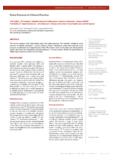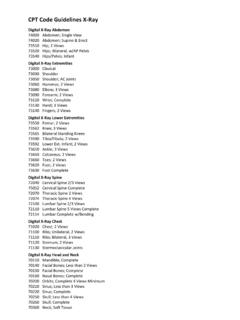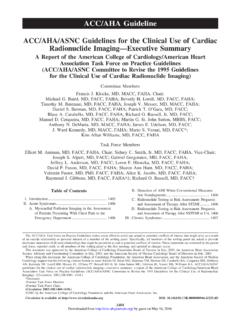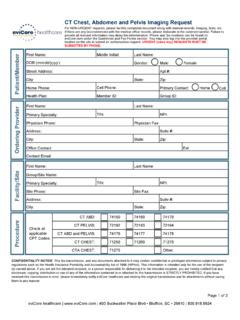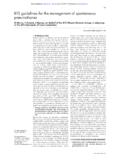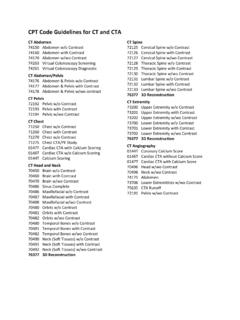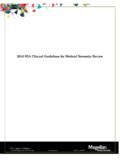Transcription of Investigating Patients with Recent Onset of Chest Pain ...
1 Chest PAIN | AUDIT REPORT. Investigating Patients with Recent Onset of Chest Pain Against NICE Guidelines in a District General Hospital Setting in the United Kingdom Azeem S Sheikh BSc MBBS FCPS MRCP1, Kamran Ali MBBS2, Azhar A Khokhar FRCP(Lon) FRCP (Glas)3 Date received: 25-08-12, Reviewed: 8-10-12, Accepted: 22-10-12. Key words: Chest pain, coronary angiography, coronary artery disease, NICE, rapid access Chest pain DOI: Background: Chest pain is a very common symptom leading to a significant number of Patients 1. Specialist Registrar in visiting the primary care trusts, emergency departments and a huge number of emergency hospital Cardiology, admissions. Newham University Hospital, NHS Trust, London 2. Senior House Officer, Objective: The objective of our audit was to investigate whether Patients with Recent Onset of Chest Department of Cardiology, pain referred to the Rapid Access Chest Pain Clinic were being investigated in accordance with Southend University Hospital, the recommendations by the National Institute for Health and Clinical Excellence (NICE), in a busy NHS Foundation Trust, District General Hospital setting.
2 Westcliff-on-Sea, Essex 3. Consultant Cardiologist, Design: Retrospective collection of data Southend University Hospital, NHS Foundation Trust, Westcliff-on-Sea, Essex Setting: Southend University Hospital NHS Foundation Trust Patients : We collected data over a period of three months for all the Patients who underwent CORRESPONDENCE. invasive coronary angiogram after being referred via Rapid Access Chest Pain Clinic (RACPC) or General Cardiology Clinic presenting with Recent Onset of Chest pain. A total of 157 Patients were Azeem S. Sheikh enrolled in the study. The Patients were then categorised into four groups based upon their Specialist Registrar in Cardiology description of symptoms, age and risk factors, as defined by NICE. Newham University Hospital NHS Trust, Glen Road, Plaistow Results: We found that 86% (135/157) Patients had estimated likelihood of CAD >60% and 51% of London, E13 8SL. these had unnecessary non-invasive investigations contrary to what NICE recommends.
3 This shows Email: that adhering to the NICE guidelines would have saved a substantial amount of hospital resources and time of the healthcare team and the Patients . Conclusions: The development of strategies for cost-conscious quality care must begin with the ACKNOWLEDGEMENTS. history, risk factors for coronary artery disease and Patients ' investigations should be based on their We acknowledge the help risk stratification. and support of all the staff at Southend University Hospital, who were associated directly or indirectly, with the collection and compilation of the data. INTRODUCTION. COMPETING INTERESTS. Chest pain and discomfort are very common The National Institute for Health and Clinical Ex- The authors report no conflict symptoms and in the United Kingdom accounts cellence (NICE) guidance on Recent Onset Chest of interest. for about 1% of visits to primary care, approxi- pain urges general practitioners (GPs) to assess mately 700,000 visits (5%) to accident and emer- the nature and timing of acute pain rapidly and AUTHORS' CONTRIBUTIONS.
4 All the authors have read and gency departments and 25% of emergency hos- arrange urgent admission for suspected acute approved the manuscript, and pital Coronary artery disease (CAD) coronary have contributed significantly. is one of many causes of Chest pain and is the AAK and ASS designed this commonest cause of death in the UK. The GPs can diagnose stable angina either on audit. ASS and KA collected clinical assessment alone or combined with di- and compiled the data and the Increasing age is related to an increase in the in- agnostic testing (anatomical testing for obstruc- results. ASS did the literature cidence of Chest pain consultations and is more tive coronary disease and/or functional testing search and wrote the initial draft common in Cardiac disease accounts for for myocardial ischaemia). The presence or ab- as well as the final manuscript. AAK, ASS and KA reviewed and only 8-18% of all cases of Chest pain 2 and when sence of the following three factors should be approved the final manuscript.
5 The cause could be cardiac in origin, appropriate noted: a constricting discomfort in the front of and timely assessment and diagnostic investiga- the Chest , or in the neck, shoulders, jaw, or arms;. tions could prevent from significant fatal events. the discomfort is precipitated by physical exer- tion and relieved by rest or Glyceryl Trinitrate (GTN) within about 5 minutes. ISSN 2042-4884. 130 EUROPEAN JOURNAL OF CARDIOVASCULAR MEDICINE VOL II ISSUE II. Investigating Patients with Recent Onset OF Chest PAIN AGAINST NICE Table 1: Diagnostic tests for people without confirmed Coronary Artery Disease (CAD). Estimated likelihood of CAD 10-29% Estimated likelihood of CAD 30-60% Estimated likelihood of CAD 61-90%. Offer CT calcium scoring Offer non-invasive functional imaging Offer invasive coronary angiography if appropraite If calcium score is: If reversible myocardial ischaemia If non-invasive functional imaging, zero, investigate other causes of Chest pain uncertain, offer invassive coronary if invassive coronary angiography not 1-400, offer 64-slice (or above) CT coronary angiography appropriate >400, follow pathway for 61-90% CAD.
6 If significant CAD uncertain, offer If significant CAD uncertain, offer non-invasive functional imaging non-invasive functional imaging If all three factors are present, the symptoms should be classified as RESULTS. typical angina; two factors are atypical of angina and one or none of these factors - non-anginal Chest pain. Once the initial assessment Out of a total of 157 Patients included in the study, 99 (63%) were is complete, the guidance recommends estimating the likelihood male. The mean age was 65 years (range: 38 88). One hundred and of coronary disease based on risk factors, age, sex and symptom forty seven (85%) had normal LV systolic function, 8 (5%) had mild classification. If clinical assessment suggests typical angina and dysfunction, 10 (6%) had moderate dysfunction and 7 (4%) had se- the estimated likelihood of coronary disease is >90%, NICE advises vere LV impairment. The Patients were risk stratified into following that further diagnostic investigation is unnecessary.
7 These Patients four groups. should be managed as having angina. If the estimated likelihood of coronary disease is <10% then other non-ischaemic causes of Chest Estimated likelihood of CAD 10 29%. pain should be considered (Table 1).3. There were 10 ( ) Patients in this group, of which 2 (20%) were The aim of our audit was to investigate whether Patients with re- male and the mean age was years (range: 44 85). with regards cent Onset of Chest pain referred to the Rapid Access Chest Pain or to non-invasive investigations, 5 (50%) Patients had an exercise tol- General Cardiology Clinics were being investigated in accordance erance test (ETT), 2 (20%) had Methoxy-isobutylisonitrile (MIBI), 1. with the recommendations by NICE, in a busy District General Hos- (10%) patient had Dobutamine Stress Echocardiogram (DSE) and 2. pital setting. (20%) Patients had CT Calcium scoring. In this low risk group, only one patient was referred for percutaneous coronary intervention (PCI) due to severe coronary artery disease.
8 The details of the vari- Patients AND METHODS ous tests and their outcomes in this group are shown in Figure 1. The coronary artery disease severity as per invasive angiogram is This was a retrospective study conducted at Southend University shown in Figure 2. Hospital NHS Foundation Trust, Essex, United Kingdom. We col- lected data over a period of three months 1st February to 30th Estimated likelihood of CAD 30 60%. April, 2011, for all the Patients who underwent invasive coronary angiogram after being referred via Rapid Access Chest Pain Clinic There were 30 (19%) Patients in this group; 9 (30%) were male and (RACPC) or General Cardiology Clinic presenting with Recent Onset the mean age was years (range 43 88). Out of these 30 pa- of Chest pain. A total of 172 Patients were enrolled in the study. Fif- tients, 7 (23%) had ETT, 5 ( ) had MIBI, 3 (10%) Patients had CT. teen Patients were excluded from the study as they did not fit into Calcium scoring whilst 11 ( ) Patients had invasive coronary the inclusion criteria and had coronary angiograms as part of the angiogram as the first line of investigation.
9 In this group, 1 ( ). work-up for severe valve disease or Investigating the cause of se- patient was referred for CABG and 3 (10%) were referred for PCI. vere left ventricular (LV) dysfunction found on transthoracic echo- The details of the various tests and their outcomes are shown in cardiogram. Figure 3. The severity of coronary artery disease as revealed by inva- sive angiogram is shown in Figure 4. After generating a list of all the Patients who had invasive coro- nary angiograms, we reviewed their age, risk factors, LV function Estimated likelihood of CAD 60 90%. and non-invasive investigations, if they had any prior to having an invasive angiogram. The data was collected from the Datacam soft- This group had 49 (31%) Patients ; 20 (41%) were male and the ware, clinic letters and Patients case notes. The Patients were then mean age was 63 years (range: 38 80). Fourteen ( ) Patients categorised into four groups based upon their description of symp- had ETT, 5 (10%) had MIBI, 3 (6%) Patients had DSE whilst 2 (4%) pa- toms, age and risk factors, as defined by NICE.
10 Tients had CT Calcium scoring followed by CT angiogram and were found to have significant CAD. EUROPEAN JOURNAL OF CARDIOVASCULAR MEDICINE VOL II ISSUE II 131. HEALTHCARE BULLETIN | Chest PAIN. Figure 1: Estimated likelihood of Coronary Artery Disease 10 29% - Overview Key to Table & Figures: Figure 4: Estimated likelihood of Coronary Artery Disease 30 60% - (number of Patients ) Angiographically coronary artery disease severity ETT: Exercise Tolerance Test MIBI: Methoxy-isobutylisonitrile (Myocardial Perfusion Scan). DSE: Dobutamine Stress Echocardiogram Angio: Coronary Angiogram Medical Mx: Medical Management CT Calcium: CT Calcium score CTA: CT Coronary Angiogram PCI: Percutaneous Coronary Intervention CABG: Coronary Artery Bypass Graft Figure 2: Estimated likelihood of Coronary Artery Disease 10 29% - Figure 6: Estimated likelihood of Coronary Artery Disease 60 90% - Angiographically coronary artery disease severity Angiographically coronary artery disease severity 132 EUROPEAN JOURNAL OF CARDIOVASCULAR MEDICINE VOL II ISSUE II.

